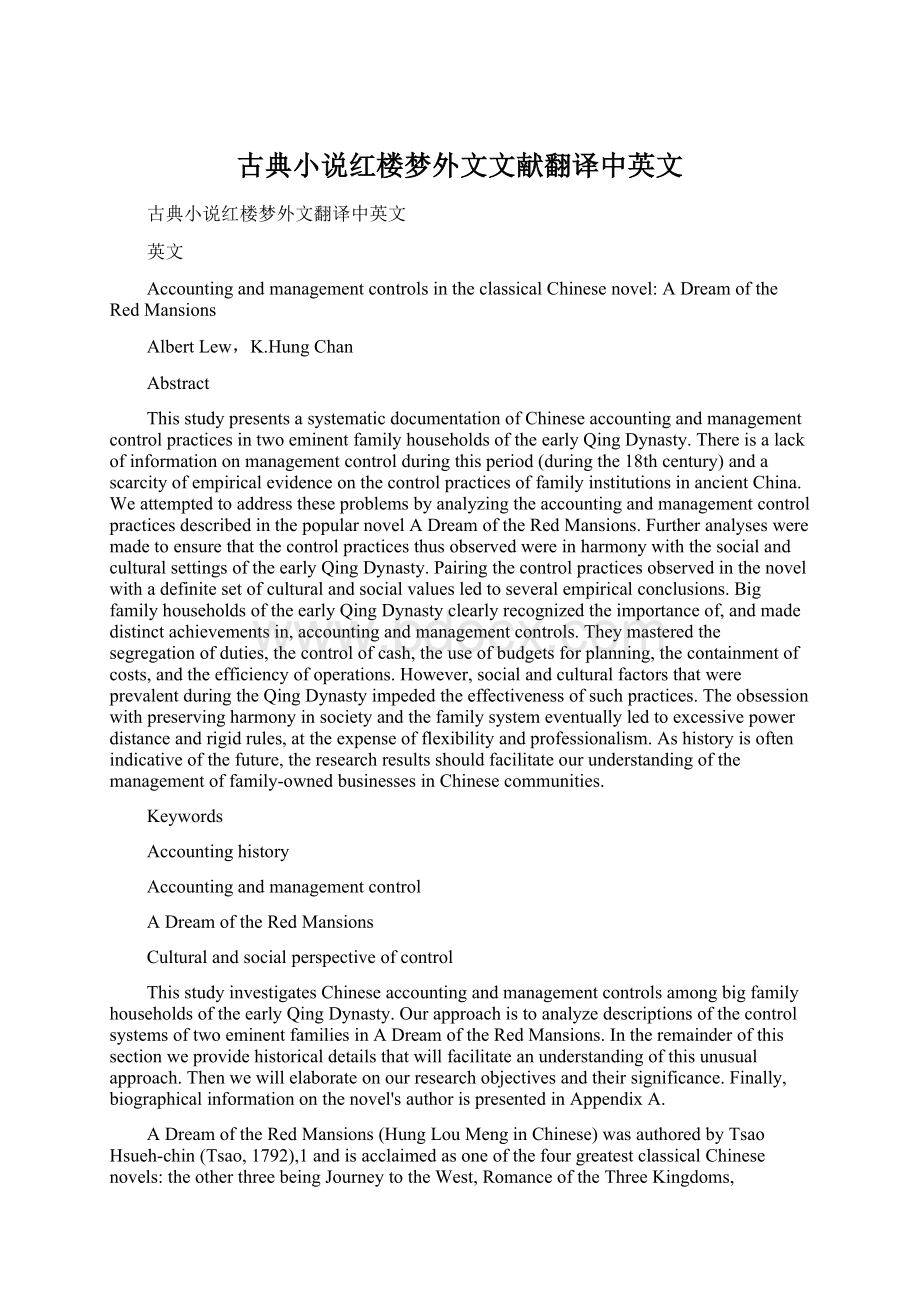古典小说红楼梦外文文献翻译中英文文档格式.docx
《古典小说红楼梦外文文献翻译中英文文档格式.docx》由会员分享,可在线阅读,更多相关《古典小说红楼梦外文文献翻译中英文文档格式.docx(6页珍藏版)》请在冰豆网上搜索。

Keywords
Accountinghistory
Accountingandmanagementcontrol
Culturalandsocialperspectiveofcontrol
ThisstudyinvestigatesChineseaccountingandmanagementcontrolsamongbigfamilyhouseholdsoftheearlyQingDynasty.Ourapproachistoanalyzedescriptionsofthecontrolsystemsoftwoeminentfamiliesin
ADreamoftheRedMansions.Intheremainderofthissectionweprovidehistoricaldetailsthatwillfacilitateanunderstandingofthisunusualapproach.Thenwewillelaborateonourresearchobjectivesandtheirsignificance.Finally,biographicalinformationonthenovel'
sauthorispresentedin
AppendixA.
ADreamoftheRedMansions
(HungLouMeng
inChinese)wasauthoredbyTsaoHsueh-chin
(Tsao,1792),1
andisacclaimedasoneofthefourgreatestclassicalChinesenovels:
theotherthreebeing
JourneytotheWest,
RomanceoftheThreeKingdoms,and
OutlawsoftheMarsh.Usingthecriteriaofmassandacademicappeal,ithasbeenwidelyacknowledgedasoneoftheworld'
smasterpieces
Levy,1999,
Lin,1935.Thenovelconsistsof120episodes,thefirst80ofwhichareacceptedastheauthenticwritingofTsao,whereasthelast40episodesareallegedtobethecontributionofKaoNgo
(Lin,1966).AlthoughKao'
snamehasneverappearedinanypublishedChineseversion,well-informedreadershavebeenawareofthiscoauthorship.2
TheinclusionofKaoasacoauthorintranslatededitionsmerelyservestoinformreadersoutsideChinaofhiscontribution.
Whatevertheprovenanceofthelast40episodes,itisclearthatTsaointendedthenoveltofaithfullyrepresenttheriseandfalloftworelatedeminentfamilies,theJungandtheNingHouses,duringtheearlyQingDynasty.Thecluetotheeminenceofthesefamiliesstemsfromtheuseof
redmansions
inthenovel'
stitle.InimperialChina,mansionswith
red-plastered
outerwallsweresymbolicofwealth,grandeur,andpower.Hence,allpalaces,temples,andcourthouseshadredwalls,whereashabitationsofcommonersweremostlygray.Tsaourgedhisreaderstoponderthisdistinction,andconsidertheliveslivedbehindredwallsaspartofa
dream.Tsaohimselfhadbeenraisedinafabulouslyluxurioushomebeforehislifewasblastedintonothingness.Inmiddleage,asabankruptscholarwholivedinadecrepithut,onlyhisimaginationcouldhelphimrelivethatdream-likepast.
Moreover,TsaousedthedreammotifbecausethetalethathenarratedwaspoliticallysensitiveintherepressiveenvironmentoftheearlyQingDynasty.Hewroteoffamilymisfortunesextendingover20years,piledonreflectionsofancestralglory,andsetamidstadesperateawarenessofthegradualerosionofsocialstatus.Mostpointedly,hedescribedtheconfiscationoffamilypropertiesthroughanimperialdecree.Tofurtherdistancehisownexperiencefromthosenarrated,Tsaodevotedsubstantialpassagestoexplainhowhesupposedlyobtainedthemanuscript.ReadersweretoldthataTaoistmonkfoundthestoryinscribedonahugerockwhichisnestledinsomefar-offmountains.ThemythicalqualityofthisconceitwasstrengthenedbyTsao'
sabsurdreferencestotherockmeasuring120feethigh,and240feetwide.Unbelievably,theTaoistmonkwassaidtohavecopiedthestoryfromtherockinscriptionsanddeliveredthemanuscriptintoTsao'
scare.
OnlyafterhavingestablishedthisalibididTsaoadmitthathethenworkedonthemanuscriptfor10years,revisingitfivetimes,anddividingitintoepisodes.Finally,hewrotethefollowingversetocommemoratetheeffort
(Lin,1935,p.270):
Thesepagestellofbabblingnonsense,
Astringofsadtearstheyconceal.
Theyalllaughattheauthor'
sfolly;
Butwhocouldknowitsappeal?
Tsao'
srhetoricalsoliloquydemandednoanswer,buthistale'
srichhumanityandtouchingsenseofpersonaltragedyhaslongbeenatalkingpoint.Episodesfromthenovelhavebeenthebasisforinnumerabletales,operas,andmovies.Toappreciatethenovel'
spositioninChinesesociety,wemustimagineaworkwiththescopeandpopularappealofMargaretMitchell'
s
GonewiththeWind
(Levy,1999).Scholars,however,lookbeyondthenovel'
sliterarymeritsalone,andtowardsTsao'
senigmaticrelationtotheeventsaboutwhichhewrote.Theyareinclinedtorejecthisclaimofwriting
babblingnonsense,andconsiderthenovelasathinlydisguisedbiographicalaccountofhistorical,social,andeconomicevents.Overthelastcentury,thesearchforhistoricalevidencetosupportthishypothesishasledtothedevelopmentofasciencecommonlyknownas
redology
inChineseliterarycircles
Alexander,1976,
Chao&
Chen,1975,
Cooper&
Zhang,1993,
Edwards,1994,
Hu,1993,
Huetal.,1961,
Knoerle,1972,
Lin,1966,
Lu,1992,
Minford,1980,
Tsai,1930,
Yu,1957,
Yu,1978,
Zhou,1989.SuchscholasticpursuitsbothinsideandoutsideChinaarecomparableindignityandvolumetocommentariesontheworksofShakespeareorGoethe
Lin,1935,
Yang&
Yang,1994.
Wearenotinterestedindeterminingwhether
ispurefictionorthinlydisguisedbiography.WhatismoreimportantisthatTsaocreatedaliterarypieceembeddedwithconcretetracesofhistoricalevidence.ThenovelwaswrittenduringthereignofEmperorChienLung(1736–1795),aperiodthathasoftenbeenheraldedbyChinesehistoriansasa“GoldenAge.”Tsao'
swritingcoveredmostwalksoflife,withextensiveandin-depthpersonalattestationtotheprevailingculture,politics,economics,socialstructure,andmanagementpracticesofthetime(Li&
Li,1995).Therefore,wetakethepositionthatthenovelhashistoricalsignificance,andisrelevanttothestudyofaccountingandmanagementcontrolsin18thcenturyChina,especiallyasalternativedocumentaryevidenceisnonexistent.
Basedonthispremise,weundertooktodrawgeneralizedconclusionsonaccountingandmanagementcontrolpracticesoftheearlyQingDynastybyreferringtovariousepisodesofthenovel.Sinceaccountingandmanagementcontrolprinciplesinductivelyderivedmighthavebeenconceptuallyfalsifiable,eitherthroughtheimaginationoftheauthororbyourownselectionbias,analysesweremadetoensurethatgeneralizationsdrawnfromthenovelwereconsistentwiththesocialandeconomicenvironmentoftheearlyQingDynasty.Itwasexpectedthatpairingtheobservedsystemofaccountingandmanagementcontrolswithbothtimeandenvironmentwouldeventuallyleadtoreasonableexplanations,notonlyfortheuniquecharacteristicsofthesystem,butalsoitsdeficienciesfromahistoricalperspective.
Theresultsofthisstudyaddtotheliterature,whichlacksareasonablepartofthepictureonaccountingandmanagementcontroloffamilyinstitutionsinimperialChina.Traditionally,researchstudiesontheaccountinghistoryofChinahavefocusedonthedevelopmentsofbookkeepingandaccountinginancientdynasties,withthefirstsingle-entrybookkeepingsystemdatingbacktotheZhouDynasty(1100–771
bc)
Aiken&
Lu,1993a,
Lu,1993b,
Lu,1998,
Fu,1971,
Lin,1992.Inthelasttwodecades,mostresearchonChineseaccountinghasbeenoccupiedwithdevelopmentssincetheeconomicreformof1979
Abdel-khaliketal.,1999,
Chenetal.,1997,
Chowetal.,1995,
Davidsonetal.,1996,
Graham&
Li,1997,
Lefebvre&
Lin,1990,
Skousen&
Yang,1988,
Winkleetal.,1994,
Xiang,1998,
Zhou,1988.Thesestudieshaverevealed,toanimportantextent,thatChinawasthenonthevergeofrapidlyadoptingor“importing”Westernaccountingandcontrolmeasures,becausepre-reformaccountingandmanagementmethodswereincapableofcopingwiththechangedpost-reformenvironment.OurexaminationoftheaccountingandcontrolsystemsemployedundertheQingDynasty,basedon
ADreamoftheRedMansions,showedasimilaratrophy.However,Chinesefamily-ownedinstitutionsofthe19thand20thcenturiesmanagedtomaintainsometraditionalmethodswhileadoptingWesternmanagementcontrolmeasures.BlendingtraditionalcontrolmeasureswithWesternmanagementcontrols